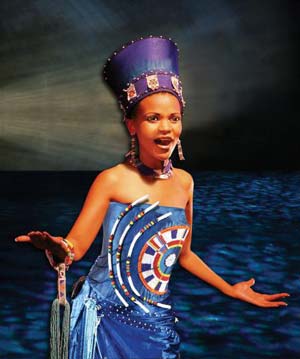
|
| African Footprint |
|
| February 7, 2008 • Sony Centre for the Performing Arts • Toronto |
|
|
|
|
|
|
Soft yet Powerful
by Tony Shivpershad |
| Two drummers played their way down the two centre aisles in a call-and-response pattern. They sauntered from the back of the room to the stage, where they were met by two others and two more joined them. They beat tribal rhythms on their African drums in the mist of the smoke filled stage. Soon lightning strikes flashed as choreographed loin-cloth clad dancers filled the stage. Thus a journey through time began.
The show, African Footprint, stomped, tapped and gumbooted its way into Toronto’s Sony Centre on its first ever tour of North America. What had begun as a millennium celebration in 1999 televised from Nelson Mandela’s former prison cell had been expanded into a full musical and had toured the world. It had been seen by 250 million before even landing in North America in late 2007 to be the first full-scale musical to play in New Orleans in that city’s post-Hurricane Katrina era.
The warriors on stage now had weapons. They fought each other with drumsticks, creating an intense tempo as they beat their drumsticks against their enemy’s drumsticks as well as on the stage. Soon the rain dissipated and a golden light shone through.
|
| The journey would continue, as a saxophone entered from stage left, and this new instrument annoyed the tribal percussionists. They tried to stave off the intrusion, but eventually left the stage in disgust. We were transported to an early 20th century shanty town as a swing jazz band played. In front of Tambo’s Tavern, tap dancers strutted in Cab Calloway-like fashion. There was soul music and even doo-wop.
On this walk through South Africa’s past, it was unavoidable that we eventually arrived at the dreadful apartheid era. This period was poignantly illustrated by two dancers, one ebony, and the other ivory. They circled each other, threatened each other and attacked each other and then a beautiful thing happened, they realized that there was a balance in each other and that united, they created a stronger South Africa than individually. All this was told in the choreography. The next issue tackled was of the traditional African woman versus the modern African woman and in song they learned that they weren’t so different after all.
|
|
 |
|
| Then there was a dance battle between river and terrestrial miners. They had a good old-fashioned stomping competition, with the river miners having bells attached to their gumboots and the terrestrial miners in work boots with taps on them.
A celebration of sport broke out with a routine that consisted of dancers dribbling footballs emblazoned with the South African colours as if they were basketballs. This is a great tribute to South African born, Steve Nash, who comes from a soccer background and is one of the greatest professional basketball players in the sport today. Balls were thrown into the audience and the audience was asked to throw them back to the stage.
Not content in displaying just the past and present of the country, the show’s finale was a glimpse of South Africa’s future. The refrain of “the future lies in unity” echoed loudly that South Africa had learned from its past.
The show had something for everyone: the musical extending from the djembe to the saxophone and acoustic guitar, and the dances uniting ballet, tap, gumboot and pantsula. The story itself was one of powerful subtlety on a journey through the South African ages.
|
|
|
|
|
|


